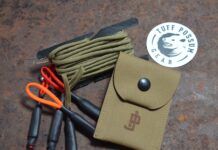
Do you see the announcement of the Antimatter Scopeswitch? It seems pretty neat and well thought out. It’s impressive, and what was equally impressive was how fast Chinese copies were already being made. China is great at ripping off intellectual property and crapping out bad replicas and copies. It’s just what they do. In the late 1950s, they did that with a little-known assault rifle known as the Type 63.
At this period, they were wielding the Type 56 assault rifle, which was an AK clone. They also had the Type 56 Carbine, which was an SKS clone. Up until the late 1950s, the Chinese and Soviets were buddies and shared weaponry and technology. In the late 1950s, there was an ideological split, and the Soviets were too keen on sharing tech and experience.

At the same time, the Chinese wanted to extend the effective range of their soldiers and arm them with a more accurate rifle. Plus, using two different rifles meant logistic pain. The differences between the SKS and AK are many, and they require different training, different parts, and even different web gear.
With all things equal, the SKS tends to be more accurate than the AK. The AK has a shorter sight radius and a clunkier long-stroke gas piston, and the SKS tended to be more rigid and ultimately more accurate. However, the SKS used a fixed magazine, was semi-auto only, and was fed with 10 round stripper clips. The AK offered removable magazines and selective fire. So the Chinese decided to form an unholy union of AK and SKS to form the Type 63.
Enter the Type 63
At first glance, the Type 63 looks like an SKS with a longer magazine. Since Tapco existed, we’ve seen that before. We’ve also seen Chinese SKS imports with the ability to take AK mags. They were commonly touted as the Para SKS. This was different.
That magazine is also removable. It looks Akish, but it is a proprietary 20-round magazine. AK magazines could be used, but this required modification of the rifle to remove the last round bolt hold open. There are also some who said that caused feeding issues. The magazine could also be fed with stripper clips through the top if necessary.

The Type 63 did offer selective fire capability with a selector placed above the trigger guard. The Chinese military used a pretty basic and well-known tactic of fire and maneuver. The rifle would be fired in semi-auto until forces closed the distance and engaged in close-quarters battle. Then the rifle could be swapped to full auto when necessary.
The Type 63 wanted to mix the accuracy of the SKS with the selective fire and removable magazine capabilities of the AK series. They also blended some of the integral features of both the AK and SKS. The gun used the short-stroke gas piston system of the SKS but used the rotary bolt from the AK series. Finding deeper details on the internals is tough, but it’s been described as complicated.

Initial evaluations proved that the rifle was durable, reliable, and accurate. The Type 63 was adopted and issued by China in 1968. They also exported guns to Vietnam during the war, Albania, and even Afghanistan to fight the Soviets.
The End of the Type 63
While initial evaluation praised the rifle, it met some snags in production. They did move from a milled to a stamped receiver. There were reportedly quality assurance issues with the gun, and it suffered from some reliability problems when it reached full production. In fact, the lifespan of the rifle went from 15,000 rounds to 10,000 rounds by the time it was issued.

Eventually, the concept fell apart as modern assault rifles entered service. The Vietnam War showed the lighter, more modern rifle was king. They dropped the Type 63 and picked up the Tpe 56 AK assault rifle and later the Type 81. The Chinese did export some SKS models marked Type 63, but they were semi-auto only and used detachable magazines. However, they were just standard SKS rifles with thumbhole stocks and detachable mags.
The Type 63 is a neat idea and one last chance for the traditional wood-stocked rifle to get some action.



